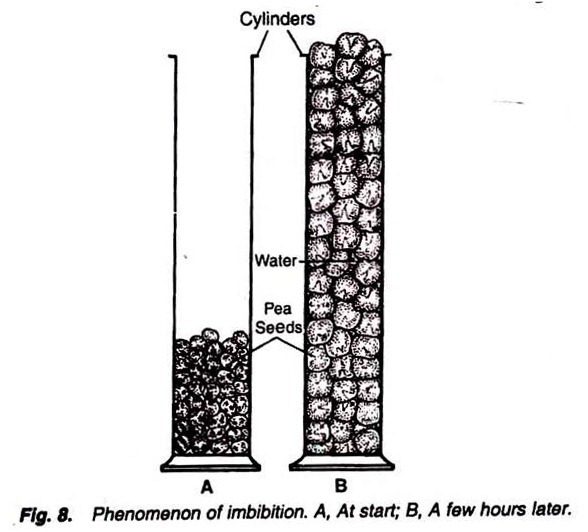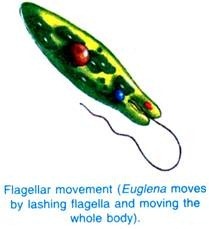The below mentioned article includes a list of three experiments on imbibition.
1. Experiment to demonstrate the phenomenon of imbibition:
Requirements:
Pea seeds, water, cylinder.
Method:
1. Take a handful of pea seeds in a cylinder and fill it with water.
2. Keep the cylinder as such for 4 to 6 hours.
Observations:
After some time the seeds have swollen and their wrinkled shape has almost disappeared (Fig.8).
Results:
Swelling of the seeds is due to the fact that water has diffused from outside into the dry seeds whose osmotic pressure is almost zero. The process of entering of water will continue so long as there is a difference in the diffusion pressure between the liquid and imbibant, i.e., pea seeds.
Modification:
The phenomenon of imbibition can also be shown by placing many other seeds like gram, bean, or many other materials such as starch, cellulose, agar, gelatin etc. in the water.
2. Experiment to demonstrate the development of imbibitional pressure by germinating seeds:
Requirements:
A bottle fitted with an air-tight cork, an air tight disc with a pointer and a scale, water, seeds.
Method:
1. Take dry seeds in the bottle and put the water in it.
2. Fix the disc with pointer and scale in this bottle. The disc should be just over the seeds (Fig. 9).
3. Fix the pointer over zero on the scale as shown in the Fig. 9 and keep the experiment for a few hours in undisturbed conditions.
Observations:
After some time it is observed that the seeds have swollen, the disc placed just over the seeds has moved slightly up and the pointer has moved slightly down on the scale. Note the initial and final readings of the pointer.
Results:
Seeds were perfectly dry in the beginning, but when placed in water they imbibed it with the help of the hydrophilic colloids of their seed testa, i.e., cellulose and pectose, and thus ultimately become swollen. Due to this swelling, a pressure is devolved with which the disc moves up and the pointer moves slightly down. This pressure is called imbibitional pressure.
3. Experiment to demonstrate that heat is liberated during imbibition:
Requirements:
Thermos flask, wheat flour, water, thermometer.
Method:
1. Take some amount of dried wheat flour in a thermos flask.
2. Pour about 50 ml of water in the thermos.
3. Now lower down a thermometer in the thermos, stir the flour slowly and note the temperature.
Observation:
The temperature is higher than the room temperature.
Results:
The increase in temperature of the dissolved wheat flour in the thermos flask is due to the imbibition of the water by the starch of wheat. This shows that heat is liberated during imbibition.

